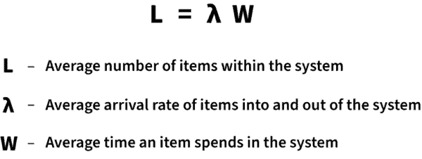Little's Law
Connects throughput, WIP, and cycle time; enables system design.
"For a given process, in general, the more things that you work on at any given time (on average) the longer it is going to take for each of those things to finish (on average)."

(W = L / λ)
Average Cycle Time = Average Work in Progress / Average Throughput
Little's Law, formulated by John D.C. Little in 1954, is a cornerstone of queueing theory that applies broadly to systems involving workflow and queues. For a given process, in general, the more things that you work on at any given time (on average), the longer it is going to take for each of those things to finish (on average). It states that the average number of items in a system (L) equals the product of the average arrival rate of items (λ) and the average time an item spends in the system (W). In Agile environments, this principle is expressed as Work In Progress (WIP) equals Throughput multiplied by Cycle Time. Understanding and applying Little's Law enables Agile teams and organizations to optimize flow, improve delivery speed, and set realistic expectations.
Imapct on Agile Teams:
Little's Law directly influences how Agile teams manage their work and delivery processes. Its implications include:
- Insight into Workflow Health:
- Monitoring WIP, throughput, and cycle time provides teams with clear indicators of flow efficiency.
- Imbalances reveal bottlenecks and inefficiencies that slow delivery.
- Encouragement to Limit Work in Progress:
- Excessive WIP lengthens cycle time, creating delays and reducing responsiveness.
- WIP limits enhance focus and minimize context switching.
- Focus on Improving Throughput:
- Throughput gains, through removing blockers or skill improvements, complement WIP control.
- Together, they accelerate delivery and improve predictability.
- Support for Accurate Forecasting:
- With two variables known, teams can predict the third, enabling better planning and stakeholder communication.
- Enhances Predictability of Delivery:
- By understanding and managing WIP and throughput, teams reduce variability in cycle times.
- Stable cycle times enable reliable forecasting of when work will be completed, improving stakeholder trust and planning.
Scenario
A Scrum team working on a Kanban board with these parameters:
- The team processes 5 user stories per week (throughput λ = 5 stories/week).
- The average cycle time for a user story is 2 weeks (W = 2 weeks).
Applying Little's law:
L = λ x W = 5 stories/week x 2 weeks = 10 stories
This means the team can handle about 10 stories in progress at any given time. If the team takes on more stories than this limit, cycle time will increase due to overload, slowing down the delivery of individual stories.
Now consider the team increasing WIP to 18 stories without increasing throughput. Cycle time becomes:
W = L ÷ λ = 18 ÷ 5 = 3.6 weeks
This shows cycle time lengthening, illustrating how more concurrent work without improving throughput causes delays and reduces flow efficiency.
Ways to Mitigate:
Agile teams can mitigate negative effects highlighted by Little's Law by focusing on these areas:
- Limit Work In Progress:
- Set explicit WIP limits for each stage of the workflow.
- Finish work in progress before starting new items.
- Improve Throughput:
- Identify and remove bottlenecks or impediments.
- Enhance skills, automate processes, and streamline work.
- Visualize Workflow:
- Use Kanban boards or task boards to track WIP and cycle time visibly.
- Detect queue buildups and slowdowns early.
- Optimize Work Size:
- Break down large tasks into smaller, manageable increments.
- Foster Team Focus and Collaboration:
- Minimize multitasking and context switching.
- Encourage collective ownership and continuous improvement.
Conclusion:
Little's Law provides a simple yet powerful mathematical framework linking work in progress, throughput, and cycle time. For Agile teams and organizations, it underscores the risks of overloading work without improving throughput, resulting in longer cycle times and slower delivery. By understanding and applying this law, teams can enforce WIP limits, improve throughput, and ultimately deliver value faster and with greater predictability. Agile coaches should use Little's Law as a diagnostic and forecasting tool to help teams optimize flow, balance workload, and communicate realistic delivery timelines. Applying Little's Law helps teams not only accelerate delivery but also deliver value more predictably. This predictability is crucial for building stakeholder confidence, managing expectations, and aligning work to business goals effectively.
Key Takeaways
- Little's Law formula: WIP = Throughput x Cycle Time (L = λ x W).
- Cycle Time = WIP ÷ Throughput, linking work quantity and speed to delivery time.
- Increasing WIP without throughput improvements lengthens cycle time and causes delays.
- Limiting WIP improves focus, flow, and predictability.
- Improving throughput complements WIP control and accelerates delivery.
- Teams can forecast delivery times and identify bottlenecks using this relationship.
- Effective WIP and throughput management enables Agile teams to deliver value with greater predictability.
Summary
Start Less, Finish More
Little's Law is fundamental to understanding flow in Agile environments. It shows that the amount of work in progress and the speed of completing work determine how long tasks take to finish. Teams overloaded with too much work will see delivery slow, even if they are busy. To maintain fast, reliable delivery, Agile teams must manage their WIP carefully and work to improve throughput. By doing so, teams not only accelerate delivery but also improve predictability, enabling better planning and stakeholder confidence. Little's Law equips teams and organizations with a clear, universal tool for diagnosing flow issues, improving delivery, and communicating realistic expectations. Mastery of this principle is essential for effective Agile delivery and sustainable team performance.